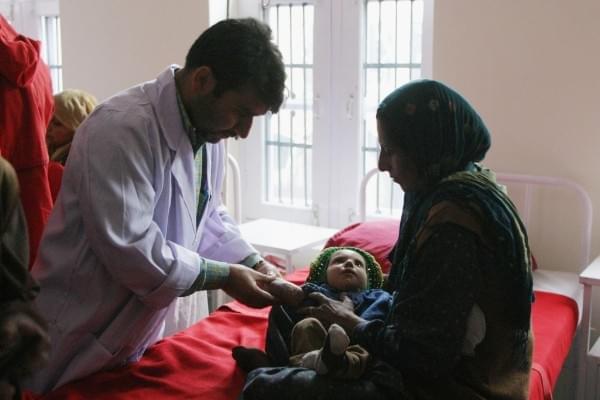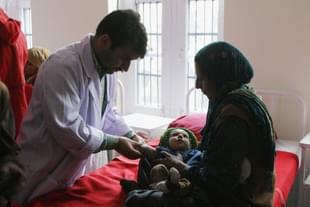Infrastructure
How Jan Arogya Abhiyan Can Create A Personalised Healthcare Ecosystem For 1.3 Billion Indians
Tushar Gupta
Sep 15, 2018, 05:11 PM | Updated 05:11 PM IST
Save & read from anywhere!
Bookmark stories for easy access on any device or the Swarajya app.


Previously named as Ayushman Bharat, the Jan Arogya Abhiyan caters to the hope and need of the 500 million Indians for whom healthcare remains a challenge even today. Jan Arogya Abhiyan is different from other health programmes, for it finds its most significant problem in its most significant opportunity - the scale.
Getting over 100 million families or 500 million citizens within a single healthcare system, in a nation like India, is unthinkable without the cooperation of the states with the central government and a thriving IT infrastructure on the back end.
Concerning population, the Jan Arogya Abhiyan serves a pool 1.6 times the size of the United States of America, 2.5 times that of Pakistan, four times that of Japan, six times that of Germany, eight times that of France, and 25 times the size of Sri Lanka. Assuming the European Union were to implement a similar scheme today for each of its citizens, it would be 25 per cent smaller in operational scale than India.
Inclusiveness has continued to remain a challenge for all public welfare schemes launched by the state or the central government. Beneficiaries for decades suffered from the middleman’s curse. Starting from the bureaucrat in the central government at the highest level to a minister at the state level, and to local officials responsible for last-mile delivery in a local village, the middleman strangled whatever public welfare scheme they could by facilitating monetary leakages in the transfer chain.
Even with questionable intent and massive leakages, the public welfare policies have been instrumental to the political discourse in India. Today, with the inculcation of tech platforms and digitisation, there are plenty of opportunities available, as the success of direct benefit transfer programme, Aadhaar, and Jan Dhan Yojana showcases.
Data, a virtual equivalent of gold as a commodity, is the key to increase the efficiency of the government and the effectiveness of a scheme for the people, for them to complement each other. Pumping resources in any public policy, without an elaborate understanding of the population being served, in this era of digitisation is as good as pushing a wall to get some mechanical work done.
This is where the philosophy around the Jan Arogya Abhiyan comes into play.
For decades, India has focussed on inculcating capacity building solutions for its population. From the Green Revolution in the 1960s to the hysteria around renewable sources of energy in the 2020s, India has always looked outward for assistance from global leaders for capacity building. Jan Arogya Abhiyan can change this.
A nation can succeed in capacity building in two ways.
One, the United States (US) way. Investing heavily in science and technology since the 1950s, the US gave us the World Wide Web where today giants like Google, Amazon, and Facebook rule the world. Within the playground of the World Wide Web, companies like Google, Microsoft, and Apple invested in peripheral and computing devices and have captured markets across the globe.
The strength of US’ capacity building can be gauged from the dependence on the Global Positioning System (GPS). Computers, across the world, from the ones in stock markets to the ones being used by space agencies use GPS to measure time to the billionth of a second. One recent bug in the GPS caused asteroid tracking satellites to go offline, BBC Radio to lose its signals and several communication errors. By 2022, over 7 billion devices would be relying on the GPS.
Two, the Chinese way. With state-backed investments in manufacturing industries, the Chinese have succeeded in product capacity building. Today, cheap Chinese products, from smartphones to Diwali lights have captured the Indian market. With magnanimous investments in the renewable industry, the Chinese are now aiming to take on the world with their indispensable clean energy products. To gauge the strength of the Chinese capacity building, one only needs to imagine an Indian market without Chinese phones. Their mere absence would alienate nine out of 10 potential smartphone users in terms of accessibility.
India, however, for many reasons, excels in neither of them.
With the implementation of the Aadhaar programme, the nation witnessed the potential leverage in public platforms. Based on four components that ensure presence less, paperless, cashless, and consent-based transactions in the realm of banking, direct benefit transfers, and soon, health care, this is India’s opportunity to create public platforms that are indispensable to the global economy.
Next, India needs to use these components to built its own playground. To put in perspective, the playgroud is an equivalent of an operating system on one’s smartphone. Direct benefit transfer, Jan Dhan Yojana, and now, Jan Arogya Abhiyan are the apps that will overlap in their use of the resources of this operating system or playground. If US’ playground was the World Wide Web, China’s was manufacturing, India’s must be public platforms built on the above stated components.
Critics may argue that the tech infrastructure of any public platform can be replicated across the globe with ease. However, this is where innovators must look beyond service-based tech infrastructure, that is relying on the private sector to aid them with platforms in the form of a continued service. The objective must be to create platforms in the form of products that can be built around a few components for any scheme on a national, state, or local level. The shift must be made from a service-based approach to a product-based one.
Data will be integral in ushering in this transformation. With a population of 1.3 billion, public welfare policies like the Jan Arogya Abhiyan should serve lessons about planning, implementation, improvisation and improvement of public platforms, for the success of any public platform will largely depend on how well it helps the scheme it was designed for.
Data analytics, complementing these lessons, should enable innovators to offer critical lessons about data and public platforms for the world to learn from. If the US could take over the world with GPS that was formerly created only for military use, there is no reason why India cannot draw lessons from the Jan Arogya Abhiyan to create public platforms for countries world over, especially those in Africa, South America, and the Middle East for they would look to harness their resources in the most profitable way.
However, why should Jan Arogya Abhiyan serve as the ideal experimentation grounds for India’s pursuit of capacity building in public platforms?
First, unlike direct benefit transfers, the nature of the Jan Arogya Abhiyan is not linear, i.e. there are multiple variables involved. Under the Direct Benefit Transfer programme, beneficiaries were being helped with resources for any single commodity, for instance, the money to purchase fertilisers. Jan Arogya offers a cover instead for a family which must not be confused with the amount credited.
Second, the raw data gained from the Jan Arogya Abhiyan would be humungous in proportions. With over a 150,000 thousand health centres, 500 million beneficiaries, the involvement of health experts from both the public and private sector, covers for secondary and tertiary hospitalisation, coverage for pre-existing diseases, and hundreds of other aspects, the Jan Arogya Abhiyan will garner data which shall require elaborate expertise to be transformed into meaningful knowledge. Ideally, the government must consider setting up a ministry for data after 2019.
Third, Aadhaar, even in its coverage of 99 per cent of the population offers no meaningful insights, for it’s more of a component to aid services like direct benefit transfers or Jan Dhan Yojana. Jan Arogya Abhiyan, even in its coverage of 500 million Indians shall garner enough insights for the agencies to prepare before they cover the remaining 800 million Indians to unify national health coverage for the entire nation or one-sixth of the world.
Apart from looking at Jan Arogya Abhiyan as a gateway to creating public platforms for the world, it is essential to look into the underlying objectives of its philosophy. By taking the bank to every house through the Jan Dhan Yojana, India has created an infrastructure that can ensure a ‘personalised credit experience’ in rural areas.
With Jan Arogya Abhiyan, the objective is to offer a ‘personalised healthcare experience’ for a particular district, depending on its geography, region prone to certain calamities like floods, and consequentially at an individual level.
Lastly, the ideal approach to moving forward is to transform the Jan Arogya Abhiyan from a treatment coverage scheme to a preventive care one, that is the data garnered across the next few years should be used not to cure diseases but to prevent them in the very first place. The personalised healthcare experience can be coupled with nutrition management, disease control, preventive care, and other aspects for an individual to lead a disease free life. This would require the culmination of some of the best minds from both the public and private sector.
Going forward, the objective for the agencies in the government must be to look at a personalised healthcare experience, credit experience, and educational experience, for the amalgamation of these three could aid the population in a grand manner, making it healthy, literate, and most importantly, self-reliant, thus aiding India in its ambition to become a $10 trillion economy somewhere in the 2030s. The process must be invested in.
For long, a majority of our population has struggled with ailments for they could not afford the treatment. Jan Arogya Abhiyan’s immediate goal is to unshackle this population from healthcare destitution while creating the first sample of a public platform that took a sample of 500 million people (or 7 per cent of the world population) from a disease-ridden society to a disease-free one.
Jan Arogya Abhiyan, for the greater good, should not only be about the Rs 500,000 cover or the 500 million Indians it insures, for there is so much more to it if only one is willing to dig deep into the philosophy behind it.
Tushar is a senior-sub-editor at Swarajya. He tweets at @Tushar15_




